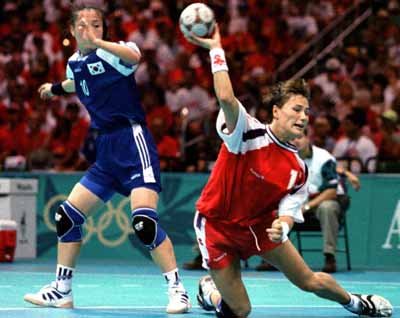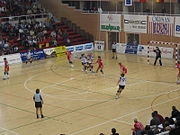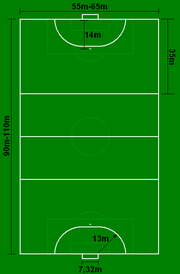Team Handball
Handball (also known as team handball, European handball, or Olympic handball) is a team sport in which two teams of seven players each (six players and a goalkeeper) pass and bounce a ball to throw it into the goal of the opposing team. Handball is a danish idea, and was created in the city Helsingør. The team with the most goals after two periods of 30 minutes wins.
Handball which is played indoors has two variants. One is field handball which was more common in the past. The other is beach handball. American handball is a completely different sport.
The modern game is most popular in Europe, where it is the second most played sport after football (soccer). The only country in Europe where it is not professionally played is the United Kingdom. Handball is not recognised as a national sport in the United Kingdom[citation needed], where the most played sport is football.
The game is quite fast and includes body contact as the defenders try to stop the attackers from approaching the goal. Contact is only allowed when the defensive player is completely in front of the offensive player, i.e. between the offensive player and the goal, the is referred as a player sandwich. Any contact from the side or especially from behind is considered dangerous and is usually met with penalties. When a defender successfully stops an attacking player, the play is stopped and restarted by the attacking team from the spot of the infraction or on the nine meter line. Unlike in basketball where players are allowed to commit only 5 fouls in a game (6 in the NBA), handball players are allowed an unlimited number of "faults," which are considered good defense and disruptive to the attacking team's rhythm.
Goals are quite common in handball; usually both teams score at least 20 goals each, and it is not uncommon to have a match end 33-31. This was not true in the earliest history of the game, when the scores were more akin to that of ice hockey. But, as offensive play has improved, particularly the use of counterattacks (fast breaks) after a failed attack from the other team, goal scoring has increased.
Contents[hide] |
[edit] Origins and development
There are records of handball-like games in medieval France, and among the Inuit in Greenland, in the Middle Ages, and in Ancient Africa, primarily Egypt. By the 19th century, there existed similar games of haandbold from Denmark, hazena in the Czech Republic, hádzaná in Slovakia, gandbol in Ukraine, torball in Germany, as well as versions in Ireland and Uruguay.
The team handball game of today was formed by the end of the 19th century in northern Europe, primarily Denmark, Germany, Norway and Sweden. The Dane Holger Nielsen drew up the rules for modern handball (håndbold) in 1898 and published them in 1906, and R.N. Ernst did something similar in 1897.
Another set of team handball rules was published on 29 October 1917 by Max Heiser, Karl Schelenz and Erich Konigh from Germany. After 1919 these rules were improved by Karl Schelenz. The first international games were played under these rules, between Germany and Belgium for men in 1925 and between Germany and Austria for women in 1930.
In 1926, the Congress of the International Amateur Athletics Federation nominated a committee to draw up international rules for field handball. The International Amateur Handball Federation was formed in 1928. The International Handball Federation was formed in 1946
Men's field handball was played at the 1936 Summer Olympics in Berlin at the request of Adolf Hitler[1]. It was removed, to return as team handball for the 1972 Summer Olympics in Munich. Women's team handball was added at the 1976 Summer Olympics.
The International Handball Federation organized the men's world championship in 1938 and every 4 (sometimes 3) years from World War II to 1995. Since the 1995 world championship in Iceland, the competition has been every two years. The women's world championship has been played since 1957. The IHF also organizes women's and men's junior world championships.
By February 2007, the IHF listed 159 member federations - approximately 1,130,000 teams and 31 million players, trainers, officials and referees.[2]
[edit] Gameplay
[edit] Formations
Players are typically referred to by the position they are playing. The positions are always denoted from the view of the respective goalkeeper, so that a defender on the right opposes an attacker on the left. However, not all of the following positions may be occupied depending on the formation or potential suspensions.
- Offense
- Left and right wingman. These typically excel at ball control and wide jumps from the outside of the goal perimeter to get into a better shooting angle at the goal. Teams usually try to occupy the left position with a right-handed player and vice versa.
- Left and right backcourt. Goal attempts by these players are typically made by jumping high and shooting over the defenders. Thus, it is usually advantageous to have tall players for these positions.
- Center backcourt. A player with experience is preferred on this position who acts as playmaker and the handball equivalent of a basketball point guard.
- Pivot (left and right, if applicable). This player tends to intermingle with the defense, setting picks and attempting to disrupt the defense formation. This positions requires the least jumping skills but ball control and physical strength are an advantage.
- Defense
- Far left and far right. The opponents of the wingmen.
- Half left and half right. The opponents of the left and right backcourts.
- Back center (left and right). Opponent of the pivot.
- Front center. Oppenent of the center backcourt, may also be set against another specific backcourt player.
[edit] Offensive play
Attacks are played with all field players on the side of the defenders. Depending on the fastness of the attack, one distinguishes between three attack waves with a decreasing chance of success:
- First Wave
- First wave attacks are characterized by the absence of defending players around their goal perimenter. The chance of success is very high the throwing player is unhindered in his scoring attempt. Such attacks typically occur after an intercepted pass or a steal and if the defending team can switch fast to offense. The far left/far right will usually try to run the attack as they are not as tightly bound in the defense. On a turnover, they immediately sprint forward and receive the ball halfway to the other goal. Thus, these positions are commonly held by quick players.[citation needed]
- Second Wave
- If the first wave is not successful and some defending players gained their positions around the zone, the second wave comes into play: The remaining players advance with quick passes in order to locally outnumber the retreating defenders. If one player manages to step up to the perimeter or catches the ball at this spot he becomes unstoppable be legal defensive means. From this position the chance of success is naturally very high. Second wave attacks became much more important with the "fast throw-off" rule.[citation needed]
- Third Wave
- The time during which the second wave may be successful is very short, as then the defenders closed the gaps around the zone. In the third wave, the attackers use standardized attack patterns usually involving crossing and passing between the back court players who either try to pass the ball through a gap to their pivot, take a jumping shot from the backcourt at the goal, or lure the defense away from a wingman.[citation needed]
The third wave evolves into the normal offensive play when all defenders reach not only the zone but gain their accustomed positions. Some teams then substitute specialized offense players. However, this implies that these player must play in the defense should the opposing team be able to switch quickly to offense. The latter is another benefit for fast playing teams.[citation needed]
If the attacking team does not make sufficient progress (eventually releasing a shot on goal), the referees can call passive play (since about 1995, the referee gives a passive warning some time before the actual call by holding one hand up in the air, signaling that the attacking time should release a shot soon), turning control over to the other team. A shot on goal or an infringement leading to a yellow card or two minute penalty will mark the start of a new attack, causing the hand to be taken down, but a shot blocked by the defense or a normal free throw will not. If it were not for this rule, it would be easy for an attacking team to stall the game indefinitely, as it is difficult to intercept a pass without at the same time conceding dangerous openings towards the goal.[citation needed]
[edit] Defensive play
The usual formations of the defense are 6-0, when all the defense players line up between the 6 meter and 9 meter lines to form a wall; the 5-1, when one of the players cruises outside the 9 meter perimeter, usually targeting the center forwards while the other 5 line up on the six meter line; and the lesser common 4-2 when there are two such defenders out front. Very fast teams will also try a 3-3 formation which is close to a switching man-to-man style. The formations vary greatly from country to country and reflect each country's style of play. 6-0 is sometimes known as “flat defense”, and all other formations are usually called “offensive defense”.{{Fact|date=December 2008}
[edit] Organization
Handball teams are usually organized as clubs. On a national level, the clubs are associated in federations which organize matches in leagues and tournaments.
[edit] International bodies
The administrative and controlling body for international Handball is the International Handball Federation (IHF). The federation organizes world championships, separate for men and women, held every second year. The final round is hosted in one of its member states. Current title holders are Germany (men) and Russia (women).
The IHF is composed of five continental federations which organize continental championships held every other second year. In addition to these competitions between national teams, the federations arrange international tournaments between club teams. The federations and corresponding tournaments are:
- Asia
- Asian Handball Federation (AHF) – Asian Handball Championship
- Pan America
- Pan-American Team Handball Federation (PATHF) – American Handball Championship
- Oceania
- Oceania Handball Federation (OHF) – Oceania Handball Nations Cup
- Europe
- European Handball Federation (EHF) – national team events: European Women's Handball Championship, European Men's Handball Championship – club team events: EHF Champions League, EHF Cup, Cup Winners' Cup and Challenge Cup.
Handball is an olympic sport played during the Summer Olympics. It is also played during the Pan American Games, All Africa Games, and Asian Games.
[edit] National
[edit] See also
Handball events have been selected as a main motif in numerous collectors' coins. One of the recent samples is the €10 Greek Handball commemorative coin, minted in 2003 to commemorate the 2004 Summer Olympics. On the coin, the modern athlete directs the ball in his hands towards his target, while in the background the ancient athlete is just about to throw a ball, in a game known as cheirosphaira, in a representation taken from a black figure vase of the Archaic period.
[edit] References
- ^ Staff (2008-05-12). "Handball a Hit in Europe: Variations of modern handball have been played since the beginning of recorded history", CBC Sports. [1]
[edit] External links
- Official Rules in English, French and German...
- International Handball Federation
- USA Team Handball's official website
- Handball Videos Explained by Thiago Simões...
- All about Handball, videos, news, rules, players...
- All about handball
- EHF Champions League
- European Beach Handball, rules, players...
- International Handball Community
- Downloads of Handball
- National Handball Teams
- Spanish Handball
- TeamHandballNews.com- Handball News and Commentary
- Dutch Handball News site
- Revised Handball
- Handballvideo
- Argentina Handball Bahìa Blanca
- Handball Live Scores
- Team Handball in New York City
- Outdoor Team handball
|
||||||||||||||||||||||||||||||||||||||||||
|
|
||













 Back to top
Back to top